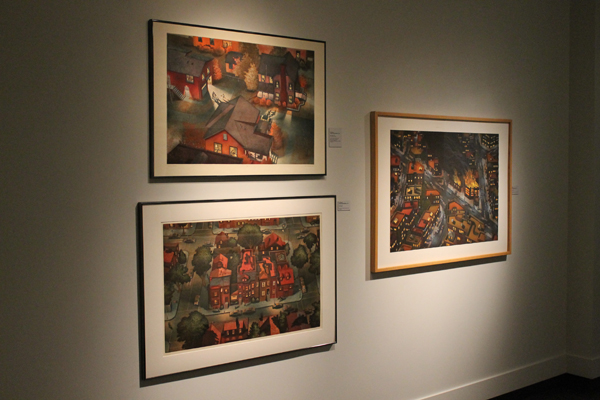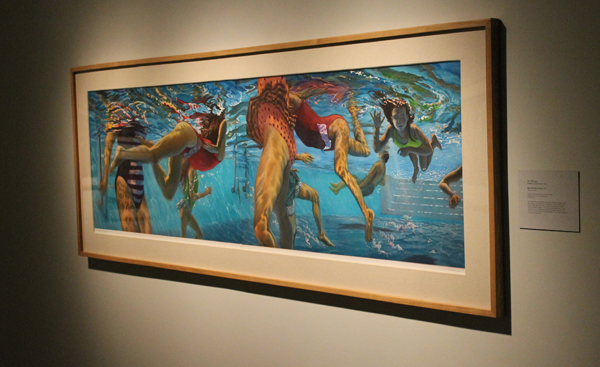
Small exhibit displays large skill at Macon museum
Three exhibits are currently on display the Museum of Arts and Sciences, a Knight Arts grantee. The largest of the three is “Ceramics from the Permanent Collection,” which features items for the museum’s collection of about 400 pieces of Georgia folk pottery and contemporary ceramics. The second is “Dixie Stewart: Gifts to the Permanent Collection.” Stewart was a world traveler and the works she collected and donated showcase a diverse range of art from around the world. The smallest is “Art Werger: Graphic Narratives.” This exhibit hangs in the tiny gallery space between the two larger exhibits, but what it lacks in space and number, it makes up for with sharper focus.
Prior to visiting the exhibit, I performed a quick search for information about Art Werger online. I knew he had been on the faculty of Wesleyan College in Macon, but I was not familiar with his body of work. His website divides his portfolio into several sections. Of those sections, three were represented in the current exhbit — cityscape, suburbanscape and submerged. A statement on the site explained, “Werger’s prints are anchored in his New Jersey childhood. His suburban scenes are lyrical and evocative of boyhood summer evening. His city scenes are fraught with tension and isolation… Werger is a Printmaker who thrives in the technical complexities of print media.”
“Downpour,” a lithograph on paper made in 1988 features silhouetted figures walking in the rain. The work is characteristic of the tension and isolation the statement describes. Part of his “cityscapes” series, this work highlights Werger’s ability to evoke emotion using light and reflection. The point of view of this work is almost eye level, which is characteristic of a subdivision of the “cityscapes” featuring silhouetted figures, often caught in inclement weather.
Within other “cityscapes,” and also with many of his “suburbanscapes,” Werger moves the point of view into the sky, working with an aerial perspective which immediately puts the viewer in a God-like position. “Neighborhood Watch,” a color etching on paper also made in 1988 is a characteristic example of this style. The work is actually a diptych, with two images, “The Fight” and “The Secret,” functioning as one continuous scene. In the left panel, a fight is breaking out and residents of the neighborhood are rushing to the scene. In the right panel, a group of neighbors gather around a glove that is lying on the ground. While each of the two panels have obvious focal points, they also feature completely unrelated scenes playing out through windows in the houses of the neighborhood. This practice evokes thoughts of the work of Edward Hopper in its portrayal of loneliness hidden within modern “community.”
In “Beneath the Surface,” Werger uses light refractions and reflections to evoke emotion.
“Beneath the Surface,” an etching on paper from 1997 depicts underwater figures and is part of the “submerged” series. These images of bodies swimming demonstrate Werger’s continued, and very successful, attempts to examine the many ways light can be used to evoke emotions within a composition. The color of these works is more vivid and appealing than many of his earlier works, but the subtle psychology still lingers just below the brightly colored surfaces.
While “Art Werger: Graphic Narratives” represents the smallest of three exhibits at the museum, the nine pieces on display are worth as much time as one can devote. This exhibit and “Dixie Stewart: Gifts to the Permanent Collection” will be on display through January 13. “Ceramics from the permanent collection will be on display through November 4.
A “Lunch and Learn” event will be held on October 11 at the museum, presented by Dr. Elizabeth Bailey, discussing “Art Werger: The Graphic Narrative.” Dr. Bailey will offer insight into Werger’s work from the perspective of an art historian and as a colleague at Wesleyan College.
The Museum of Arts and Sciences: 4182 Forsyth Rd., Macon; 478-477-3232; www.masmacon.org.
Recent Content
-
Artsarticle ·
-
Artsarticle ·
-
Artsarticle ·

